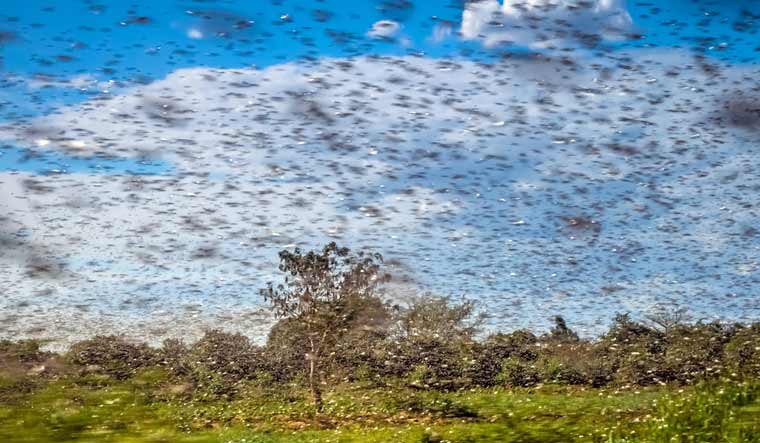By Shweta Tyagi, Chief Functionary, India Water Foundation
 The unfolding of COVID-19 pandemic and now a locust invasion has set a threatening agricultural crisis in India. With another swarm of locust attack in the forthcoming month of July as predicted by FAO, India is in the tight grip of a looming invasion. As predicted by the United Nations, India is witnessing armies of locusts swarming across the country – the worst such attack in 26 years. As if India needed more challenges, with coronavirus infections steadily increasing, a heat wave hitting the capital, a recent killer cyclone and 100 million people out of work, the country now has to fight off a new problem: a locust invasion. The insects are destroying crops even as the country has been brought to a standstill amid the coronavirus pandemic. Swarms of locusts, many billions strong, were moving from East Africa to West Asia and South Asia, “decimating livelihoods and devouring food”, said David Malpass, President of the World Bank Group, adding the locust swarms threatened a “monumental crisis” and “a humanitarian emergency.” COVID-19 has also impacted the locust response by delaying the delivery of pesticides and limiting the ability of people to organize awareness sessions for affected communities. There are concerns that the economic impacts of COVID-19 will be compounded by the economic impacts of the locust swarms.
The unfolding of COVID-19 pandemic and now a locust invasion has set a threatening agricultural crisis in India. With another swarm of locust attack in the forthcoming month of July as predicted by FAO, India is in the tight grip of a looming invasion. As predicted by the United Nations, India is witnessing armies of locusts swarming across the country – the worst such attack in 26 years. As if India needed more challenges, with coronavirus infections steadily increasing, a heat wave hitting the capital, a recent killer cyclone and 100 million people out of work, the country now has to fight off a new problem: a locust invasion. The insects are destroying crops even as the country has been brought to a standstill amid the coronavirus pandemic. Swarms of locusts, many billions strong, were moving from East Africa to West Asia and South Asia, “decimating livelihoods and devouring food”, said David Malpass, President of the World Bank Group, adding the locust swarms threatened a “monumental crisis” and “a humanitarian emergency.” COVID-19 has also impacted the locust response by delaying the delivery of pesticides and limiting the ability of people to organize awareness sessions for affected communities. There are concerns that the economic impacts of COVID-19 will be compounded by the economic impacts of the locust swarms.
Unusual large locust swarms bred on the Arabian Peninsula in early 2019 following heavy rains and cyclones in the region, according to AFP (Agence France-Presse). Those ideal breeding conditions were the product of the climate crisis, as warmer than usual temperatures in the western Indian Ocean fueled the storms. According to climate scientist Roxy Mathew Koll of Indian Institute of Tropical Meteorology, “These warm waters were caused by the phenomenon called the Indian Ocean Dipole — with warmer than usual waters to its west, and cooler waters to its east. Rising temperatures due to global warming amplified the dipole and made the western Indian Ocean particularly warm.
Stephen Rogers of Cambridge University, U.K. (and University of Sydney, Australia) is an acknowledged world expert in the study of how and why such swarms come about. In one of his papers, way back in 2003, he showed that when solitary locusts happen to come near each other (looking for food) and happen to touch each other, this tactile stimulation, even just in a little area of the back limbs, causes their behaviour to change. This mechanical stimulation affects a couple of nerves in the animal’s body, their behaviour changes, leading to their coming together. And if more locusts come nearby, the crowding starts, and what was once a simple looking insect becomes larger in size and shape, and its colour and morphology changes.
India is equipped with a proper structure that is responsible to deal with the locust crisis. Our country has a regular system in place comprising Locust Officers. These authorized people with the knowledge of environment and agriculture organise six annual border meetings with Pakistan between June and November to analyse the situation and take necessary action. The dialogue is either organized at Munabao in Rajasthan or Kokhropar on the Pakistani side. A wireless conversation also keeps happening between the officials of the two countries during these months from Jodhpur in India and Karachi in Pakistan. As per the Locust Warning Organisation (LWO), India has not seen any locust upsurges since December 2011 and the cases have decreased drastically after the advent of new technologies in the agricultural sector including advancement in pest control market. The country has been hit by locust plague several times between 1812 to 1997. Locusts are not uncommon in the northwest Indian state of Rajasthan, but this year they have also entered the states of Madhya Pradesh and Uttar Pradesh for the first time since 1993 and the state of Maharashtra for the first time since 1974. The worst-affected districts in Rajasthan are Barmer, Jaisalmer and Nagaur. Because most of the crops were recently harvested, the hungry swarms have buzzed into urban areas, eager to devour bushes and trees, carpeting whatever surface they land on.
The current upsurge is alarming in the Eastern Africa region. FAO has projected that over 25 million people will face acute food insecurity in the region in the second half of 2020. In Yemen, where locusts have been reproducing in hard-to-access inland areas, 17 million people may be impacted. A swarm of locust spread over a square kilometre can chew through food enough for 35,000 people in a day. In Pakistan, 38 percent of the area (60 percent in Baluchistan, 25 percent in Sindh and 15 percent in Punjab) are breeding grounds for the desert locust, whereas the entire country is under the threat of invasion if the desert location is not contained in the breeding region,” according to an FAO report.
They can fly as far as 150km a day, making them difficult to control. Locust swarms can cover extremely large areas, which can sometimes be extremely remote and difficult to access. FAO monitors locust swarms on a 24-hour basis and provides forecasts and early warning alerts on the timing, scale and location of movement. Traditional chemicals are used to control their numbers. Now nature-based biopesticides are also available as a less harmful alternative for controlling outbreaks. In Rajasthan, the state agriculture department had deployed over 100 vehicles for locust swarm monitoring, and over 800 tractor-mounted sprayers and almost 3,000 water tankers were pressed into service to tackle the invasion. Measures are being taken to build up stocks of tractor-mounted sprayers, fire tenders and even purchasing drones to spray pesticides from the sky.
The World Bank has set up a $500 million program to fight the locust infestation in East Africa and parts of West Asia, which is said to cause economic damage costing $8.5bn this year. A trilateral plan among Iran, Pakistan and India is being formulated to address locust swarm infestations that devour crops and threaten the livelihood and sustenance in the region, already struggling with coronavirus pandemic. Last month, Union Agriculture Minister Narendra Singh Tomar chaired a meeting to take stock of the situation. Control involves spraying insecticide on locusts’ night resting places like trees. Till date, the LWO has carried out spraying over 21,675 hectares in Rajasthan. India has also put an order of 60 specialized insecticide sprayers with the UK, the country already has 50 such machines. Also, drones will be used to spray the resting places.
The locust attack if not contained shall have far reaching effects on agricultural productivity, devastating crops which in turn will affect food security and the monetary returns of the farmers. Losses incurred are bound to create agricultural distress leading to large scale loss with disproportionate impact to the livelihoods of farmers and economy as well. With the coming of monsoon season and onset of Kharif harvest crops, the repercussion of locust resurgence is already forecasted beyond imagination. Time to move beyond Wait and Watch policy!!

